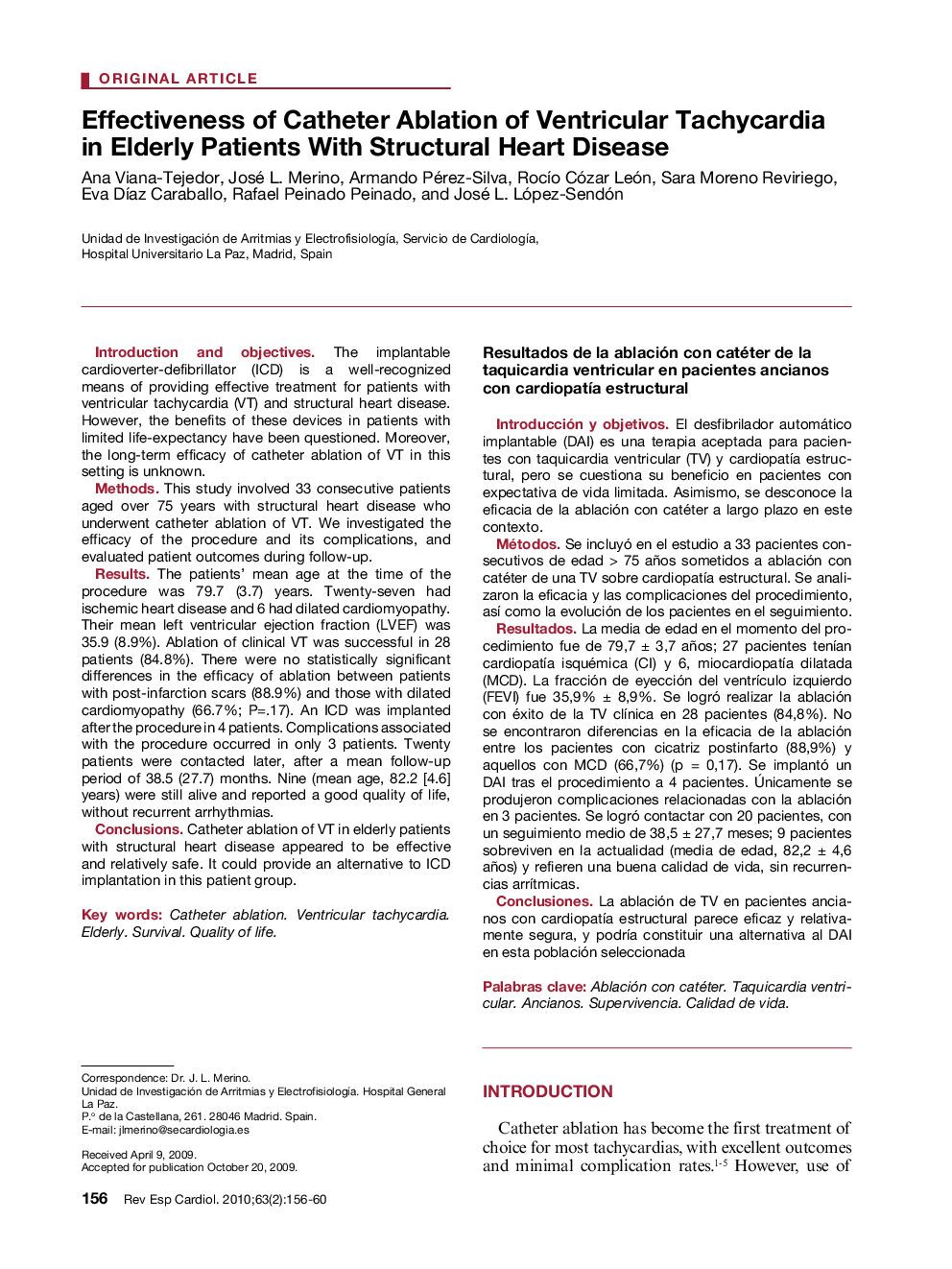| Article ID | Journal | Published Year | Pages | File Type |
|---|---|---|---|---|
| 3017325 | Revista Española de Cardiología (English Edition) | 2010 | 5 Pages |
Introduction and objectivesThe implantable cardioverter-defibrillator (ICD) is a well-recognized means of providing effective treatment for patients with ventricular tachycardia (VT) and structural heart disease. However, the benefits of these devices in patients with limited life-expectancy have been questioned. Moreover, the long-term efficacy of catheter ablation of VT in this setting is unknown.MethodsThis study involved 33 consecutive patients aged over 75 years with structural heart disease who underwent catheter ablation of VT. We investigated the efficacy of the procedure and its complications, and evaluated patient outcomes during follow-up.ResultsThe patients’ mean age at the time of the procedure was 79.7 (3.7) years. Twenty-seven had ischemic heart disease and 6 had dilated cardiomyopathy. Their mean left ventricular ejection fraction (LVEF) was 35.9 (8.9%). Ablation of clinical VT was successful in 28 patients (84.8%). There were no statistically significant differences in the efficacy of ablation between patients with post-infarction scars (88.9%) and those with dilated cardiomyopathy (66.7%; P=.17). An ICD was implanted after the procedure in 4 patients. Complications associated with the procedure occurred in only 3 patients. Twenty patients were contacted later, after a mean follow-up period of 38.5 (27.7) months. Nine (mean age, 82.2 [4.6] years) were still alive and reported a good quality of life, without recurrent arrhythmias.ConclusionsCatheter ablation of VT in elderly patients with structural heart disease appeared to be effective and relatively safe. It could provide an alternative to ICD implantation in this patient group.
Introducción y objetivosEl desfibrilador automático implantable (DAI) es una terapia aceptada para pacientes con taquicardia ventricular (TV) y cardiopatía estructural, pero se cuestiona su beneficio en pacientes con expectativa de vida limitada. Asimismo, se desconoce la eficacia de la ablación con catéter a largo plazo en este contexto.MétodosSe incluyó en el estudio a 33 pacientes consecutivos de edad > 75 años sometidos a ablación con catéter de una TV sobre cardiopatía estructural. Se analizaron la eficacia y las complicaciones del procedimiento, así como la evolución de los pacientes en el seguimiento.ResultadosLa media de edad en el momento del procedimiento fue de 79,7 ± 3,7 años; 27 pacientes tenían cardiopatía isquémica (CI) y 6, miocardiopatía dilatada (MCD). La fracción de eyección del ventrículo izquierdo (FEVI) fue 35,9% ± 8,9%. Se logró realizar la ablación con éxito de la TV clínica en 28 pacientes (84,8%). No se encontraron diferencias en la eficacia de la ablación entre los pacientes con cicatriz postinfarto (88,9%) y aquellos con MCD (66,7%) (p = 0,17). Se implantó un DAI tras el procedimiento a 4 pacientes. Únicamente se produjeron complicaciones relacionadas con la ablación en 3 pacientes. Se logró contactar con 20 pacientes, con un seguimiento medio de 38,5 ± 27,7 meses; 9 pacientes sobreviven en la actualidad (media de edad, 82,2 ± 4,6 años) y refieren una buena calidad de vida, sin recurrencias arrítmicas.ConclusionesLa ablación de TV en pacientes ancianos con cardiopatía estructural parece eficaz y relativamente segura, y podría constituir una alternativa al DAI en esta población seleccionada
